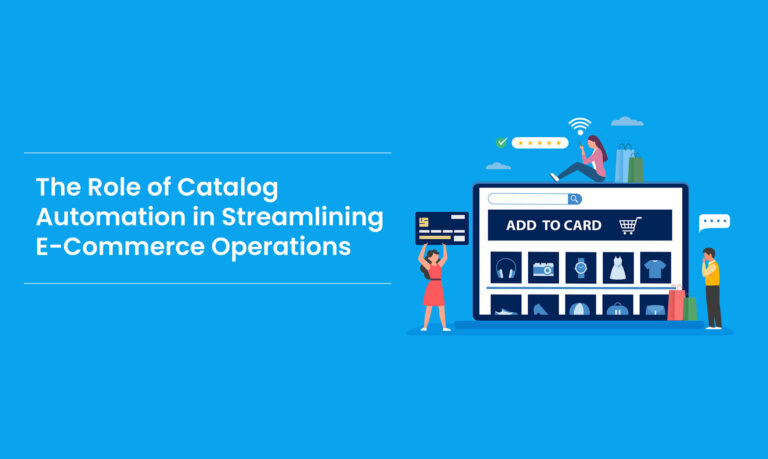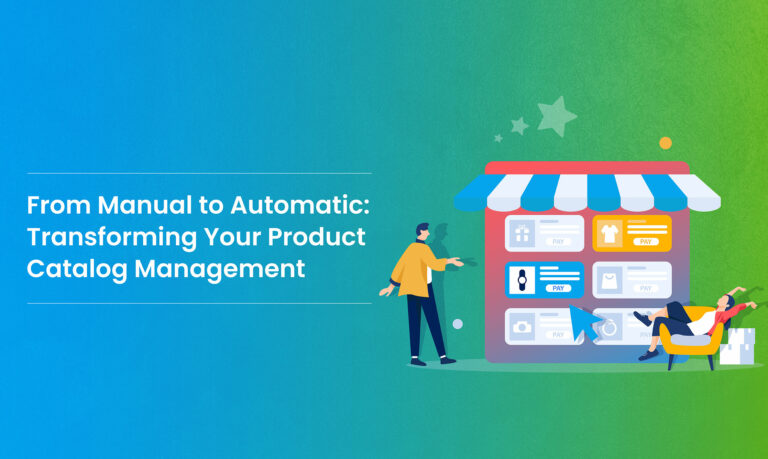Introduction
Strategic use of new technology is not simply an option in the ever-changing world of e-commerce; it is a need. Explore the revolutionary potential of cataloging automation, perfectly combined with the expertise of Automated Inventory Management. Together, these technologies will reshape the online retail scene, promising increased efficiency, unrivaled precision, and a significant increase in sales.
Here’s a closer look at the importance of AI Cataloging Automation in e-commerce:
- Efficiency and Time Savings: AI Cataloging automation renders obsolete the labor-intensive, traditional processes involved in creating and maintaining catalogs.
- Real-time Updates: Real-time modifications to the product catalog are possible with cataloging automation. This is essential in a constantly changing e-commerce landscape where product availability, costs, and other specifics might alter regularly. Customers receive the most recent and correct information through real-time updates, which lowers the possibility of miscommunication or discontent.
Scalability: Automation of cataloging grows easily with e-commerce enterprises as they develop and diversify their product offers. While managing a growing catalog of items by hand might become daunting, effective catalog solutions allow for growth with the catalog without sacrificing precision or performance.
What is Cataloging Automation in E-commerce?
In e-commerce, the term “cataloging automation” refers to the creation, management, and organization of product catalogs by automated procedures and instruments. A product catalog, as used in e-commerce, is an exhaustive inventory of all the goods and services that a store or company sells. The laborious and time-consuming manual processes involved in keeping an accurate and well-organized product catalog are streamlined by cataloging automation.
Key Advantages of Smart Merchandising
Listed below are the key advantages of cataloging automation to boost e-commerce sales.
- Maximized Product Visibility for Increased Clicks and Conversions: Cataloging Automation uses SEO-optimized product listings that include important keywords to get higher search engine rankings. According to research, items that appear on the first page of search results receive considerably more hits and conversions. This increased visibility not only draws new consumers but also develops the brand’s authority in the digital marketplace, resulting in long-term organic development.
- Resource Optimization for Strategic Focus: Teams may concentrate on strategic projects by freeing up important human resources from repetitive cataloging duties thanks to cataloging automation. Studies reveal a positive association between organizations that engage customers and invest in effective marketing efforts and higher sales. Businesses not only streamline their operations but also open up opportunities for long-term growth and competitiveness in the ever-changing e-commerce market by reallocating human capital to more significant areas.
- Dynamic Pricing Reliability for a Competitive Advantage: By integrating dynamic pricing algorithms, cataloging automation gives companies the flexibility to modify prices instantly. Research indicates that implementing dynamic pricing tactics leads to heightened competition and enhanced profits. Through the examination of market patterns, rival pricing strategies, and variations in demand, companies may adapt their prices in real-time to maintain their appeal to clients and optimize earnings. This price accuracy gives a substantial competitive advantage in the dynamic e-commerce sector.
- Unmatched Accuracy for Developing Customer Trust and Loyalty: Using Cataloging Automation to manage product information precisely is essential to developing customer trust and loyalty. Research indicates that inaccurate information about a product, such as false descriptions or photos, increases the likelihood of returns and lowers consumer satisfaction. By providing accurate and consistent information, companies build trust with their clientele, which promotes loyalty and repeat business.
- Personalized Shopping Experiences: The development of individualized shopping experiences is made easier by cataloging automation, which is powered by data analysis of consumer activity. Personalized product recommendations, according to research, greatly improve consumer engagement and raise the possibility of profitable cross-selling and upselling. Businesses may provide product recommendations that are specific to each client by learning about their preferences. This builds a stronger bond with customers and promotes recurring business. In addition to increasing sales, this tailored strategy strengthens the brand’s reputation as being customer-focused.
- Improved Conversions and Seamless Navigation: Product catalogs are better organized thanks to cataloging automation, which applies useful filters and classifications. Research demonstrates that a well-structured and efficient catalog greatly enhances user experience and boosts conversions. Simple navigation makes it easier for users to discover items, which lowers bounce rates and raises the possibility that they will finish their purchase. Companies who emphasize having an easy-to-use catalog structure see an increase in conversion rates, which highlights how important Cataloging Automation is to improving the customer journey as a whole.
- Operational excellence through Effective Inventory Management: Effective control over stock levels is ensured by the combination of Automated catalog management and inventory management systems. According to research, stockouts may be avoided, and overselling can be prevented with proper inventory management. Meeting customer expectations and achieving operational excellence are two important goals that are facilitated by automated real-time product availability updates. Improved order fulfillment rates and enhanced customer satisfaction are experienced by businesses that use automation to ensure exact inventory control, which leads to more sales and happier customers.
- Agility to Market Trends for Continuing Relevance: Businesses can quickly adjust to new market trends because of cataloging automation. According to research, there is a favorable correlation between sales and matching product offers with current customer preferences. Businesses may ensure ongoing relevance and resonance with their target audience by updating product listings promptly and utilizing automated systems that evaluate market trends. This flexibility helps the business to be seen as responsive and forward-thinking, which builds consumer loyalty and trust. In the dynamic world of e-commerce, being aware of market trends via Cataloging Automation is essential for long-term success.
- Multichannel Integration for Increased Brand Reach: Automated catalog management makes it easier to integrate many channels seamlessly, which increases the reach of a brand. Businesses that use multichannel methods report more consumer reach and engagement, according to a wealth of data. By maintaining a unified brand presence across many channels, companies may reach a wide range of customer demographics and optimize their visibility. By positioning the company as approachable and ubiquitous, multichannel integration not only broadens the client base but also opens up new avenues for growth in sales and market share.
- A/B Testing as a Tactic for Strategy: A/B testing that is automated and driven may be a tactical tool for improving product listings. Studies show that companies doing A/B testing gain important insights into the preferences of their customers, which boosts conversion rates. Businesses may optimize their catalog for optimum effect by experimenting with various features, including photos, descriptions, and pricing schemes. With Cataloging Automation’s help, A/B testing turns into a data-driven strategy for ongoing improvement, making sure that the product listings appeal to the target market the most and, eventually, increase sales.
- Improved Customer Satisfaction with Real-Time Inventory Updates: Automated inventory management integration guarantees real-time updates on product availability. Studies show that timely and correct information about a product’s availability has a direct impact on consumers’ decisions to buy. Stockouts and backorders are reduced when companies use automation to give clients real-time inventory changes. In addition to meeting consumer expectations, this openness in inventory management builds confidence and encourages recurring business and favorable word-of-mouth, both of which eventually result in higher sales.
- Cost-Effective Marketing Strategies: Businesses may implement more focused and economical marketing tactics when they combine cataloging automation with precise product data and tailored suggestions. Personalized marketing initiatives have been shown to increase engagement and conversion rates through extensive research. Businesses may maximize return on investment by allocating marketing resources more efficiently through the use of automation for data-driven decision-making. Cataloging automation-powered cost-effective marketing makes sure that advertising campaigns provide the best possible outcomes, which boosts sales and maintains profitability.
- Data-Driven Strategic Decision-Making: Businesses may gain important insights into customer behavior and product performance via the use of cataloging automation. Studies highlight how important data-driven decision-making is to attaining strategic breakthroughs. Businesses may make strategic decisions that meet customer expectations by examining this data to find trends, preferences, and areas for development. A potent combination for being ahead of the competition, promoting continual development, and eventually leading to higher sales and market share is the merging of cataloging automation with data-driven decision-making.
- Consistent Operational Professionalism: Product information is presented consistently and expertly across a variety of platforms thanks to cataloging automation. Studies emphasize that maintaining consistency in a brand’s depiction is crucial for establishing credibility and trust. Companies are more likely to draw in and keep clients if they provide a consistent, polished image across all platforms. A characteristic of operational professionalism is consistent product information, which is attained through cataloging automation. This enhances brand impression and, as a result, boosts sales.
- Long-Term Competitive Advantage in the Changing Market: Cataloging automation gives firms a long-term competitive advantage through its capacity to adapt, be efficient, and prioritize the needs of their customers. Studies show that companies that use technology to solve problems have a higher chance of succeeding than those that don’t. This competitive advantage becomes essential for long-term success in the ever-evolving e-commerce business as customer preferences and market trends change quickly. By putting companies in a customer-focused, responsive, and flexible position, cataloging automation lays the groundwork for long-term growth, higher revenue, and market leadership.
Conclusion
Cataloging automation is an empowering tool that enables companies to overcome obstacles, react quickly to changes in the market, and offer a superior level of customer service. As we navigate the complexities of the digital marketplace, it becomes clear that Rubick.ai is more than simply a solution; it is the spark for reinventing how businesses flourish online. As we draw to a close, it is clear that cataloging automation is more than simply a feature. Rather, it is the force behind enterprises’ advancement toward a future in which success is not only attained but also constantly redefined. The advantages that are covered here are not fixed successes; rather, they are stepping stones toward a time when e-commerce success is conceivable, and the path is characterized by creativity, tenacity, and steady progress.

